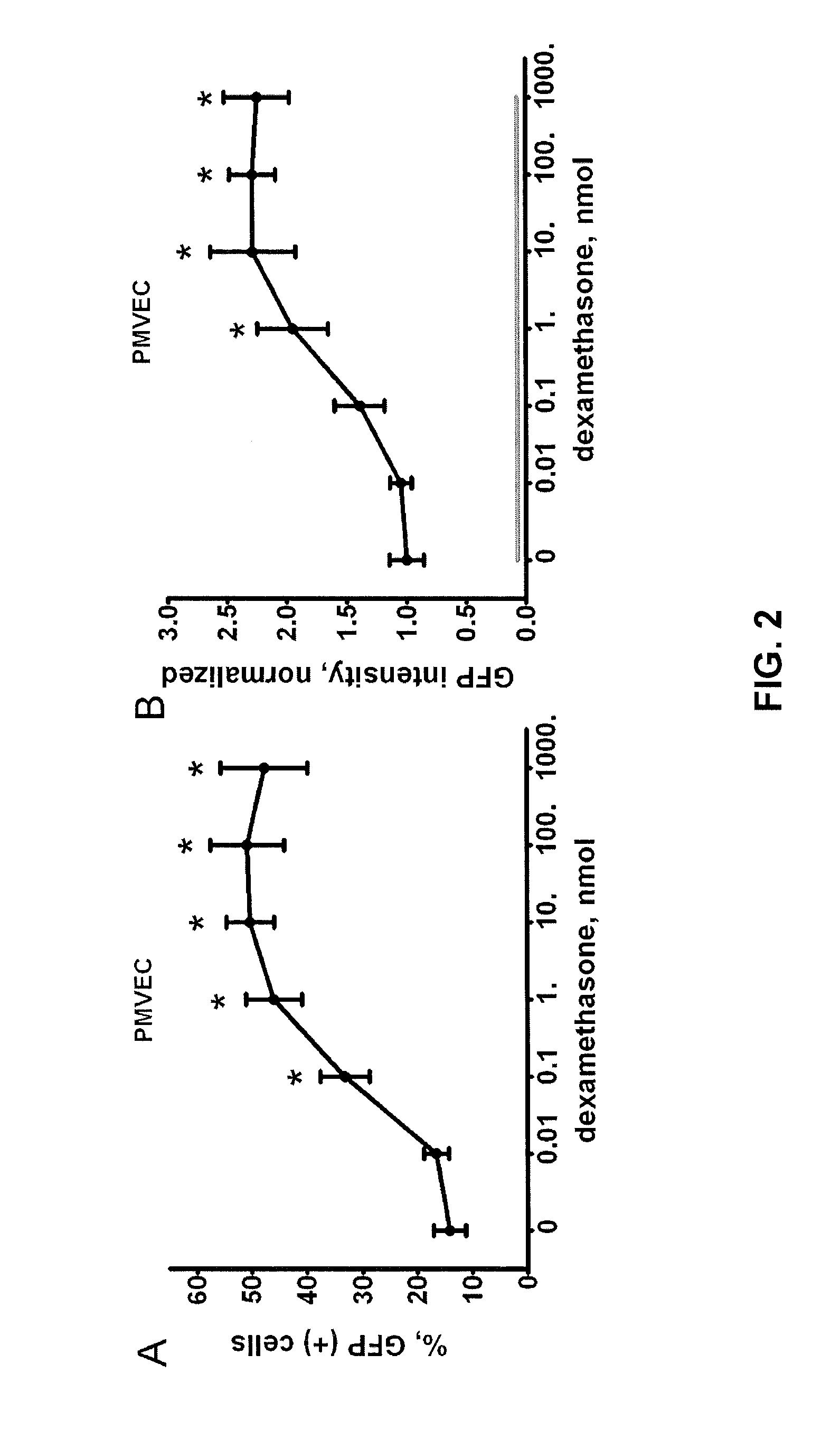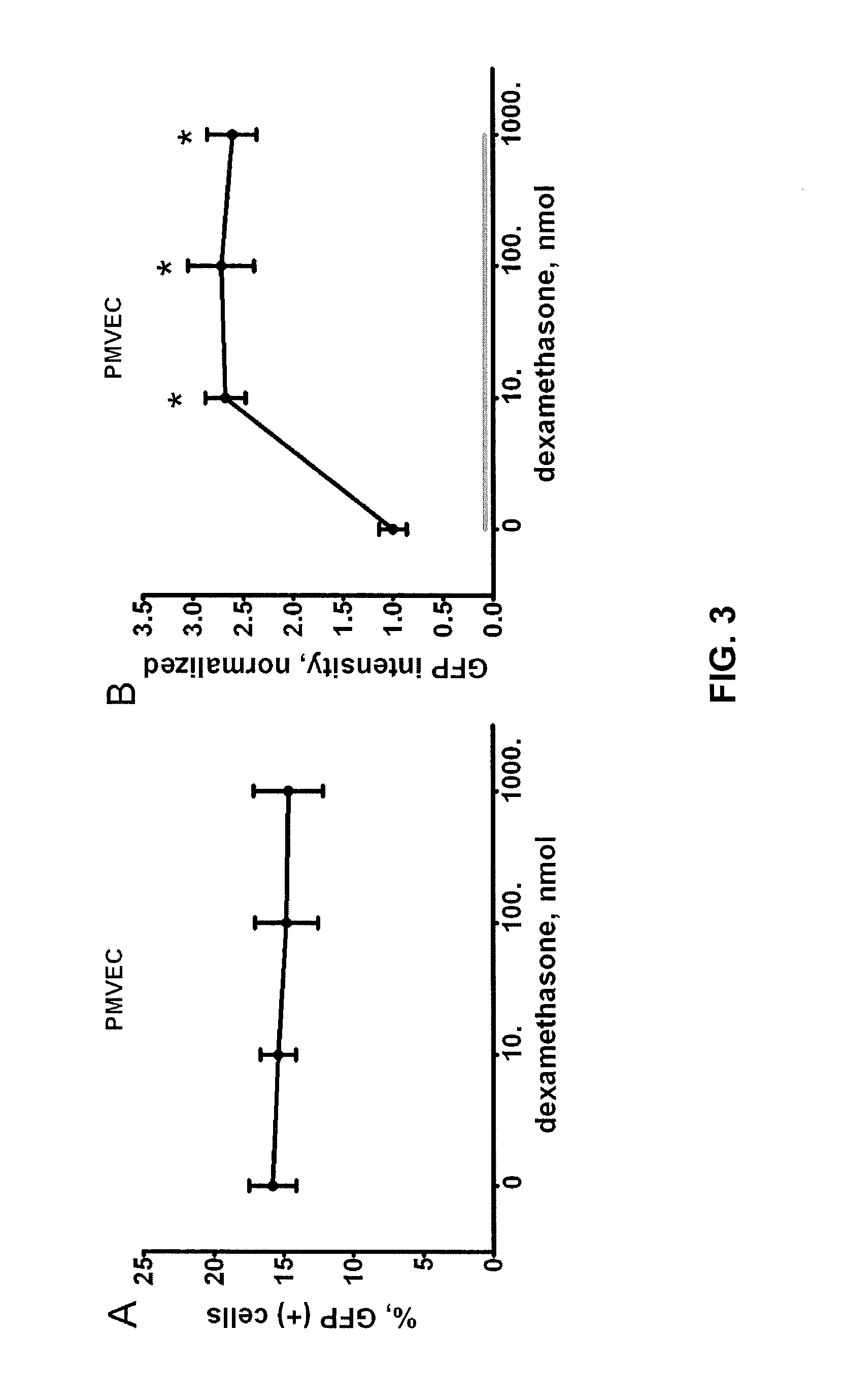Method for increasing retroviral infectivity
a retroviral infection and infectivity technology, applied in the field of increasing the infectivity of retroviral cells, can solve the problems of low retroviral infection efficiency of target cells, limited use of retroviral vectors, and complex methods of virus concentration, so as to enhance the integration of the retrovirus, and enhance the infectivity of a retrovirus
- Summary
- Abstract
- Description
- Claims
- Application Information
AI Technical Summary
Benefits of technology
Problems solved by technology
Method used
Image
Examples
example 1
Dexamethasone Enhances Expression of Viral Proteins and Increases Retroviral Titer
[0074]We first tested the ability of dexamethasone to increase retroviral protein production in Phoenix cells with integrated pro-viruses using GFP as a reporter. We cultured cells for 36 hrs in DMEM supplemented with 10% FBS and varying concentrations of dexamethasone. We then analyzed the Phoenix cells for GFP expression by flow cytometry. As shown in FIG. 1A, dexamethasone at concentrations of 10 nmol and higher, more than doubled GFP levels in these cells. We confirmed this by Western blot analysis of cell lysates obtained from vehicle and dexamethasone-treated cells (FIG. 1B). To determine if this increase in GFP expression correlated with an increase in viral titer in the supernatant, we performed quantitative RT-PCR on the conditioned medium using primers for the GFP region of the viral RNA. Viral titer increased in a dose-dependent manner reaching a plateau at 10 nmol of dexamethasone (FIG. 10)...
example 2
Reducing Steroid Hormones in FBS Decreases Activation of LTR Promoter and Reduces Viral Titer
[0078]Since steroid hormones present in serum may activate the LTR promoter at baseline (i.e. before the addition of dexamethasone), we examined whether reducing these steroids in serum would decrease virus propagation and infectivity. We grew Phoenix cells with an integrated pro-virus expressing GFP to maximum confluence in DMEM supplemented with 10% charcoal-stripped FBS (which has a reduced steroid hormone content) (8) for 72 hours. GFP expression in these cells was less than half that of cells exposed to regular FBS (FIG. 4A). Using primers for the GFP region of the viral RNA we performed quantitative RT-PCR of the conditioned medium and found a decrease in retroviral RNA levels in collected medium obtained from packaging cells grown in charcoal-stripped FBS. The viral titers correlated directly with the GFP levels in Phoenix cells (FIG. 4B). The conditioned medium collected from packagi...
example 3
The Glucocorticoid Receptor Antagonist, Mifepristone, Increases Target Cell Infectivity Independent of Viral Titer
[0079]The retroviral LTR promoter is known to have hormone response elements (5, 12) and it appeared that this promoter was stimulated not only by dexamethasone, but by steroid hormones within FBS that can be removed by charcoal (FIG. 4). Mifepristone (RU 486) is a glucocorticoid (and progesterone) receptor antagonist that can act as an abortifacient (4). We tested the effect of varying concentrations of mifepristone on retroviral production in Phoenix cells. We grew cells to 50% confluence (as described above) in the presence of increasing concentrations of mifepristone (0-20 μmol), but without dexamethasone. Conditioned medium was then collected and applied directly to PMVEC. After 12 hours the conditioned medium was replaced with fresh medium with the same concentration of mifepristone for an additional 72 hours. Cells were then collected and analyzed for GFP expressi...
PUM
| Property | Measurement | Unit |
|---|---|---|
| Sensitivity | aaaaa | aaaaa |
| Time | aaaaa | aaaaa |
Abstract
Description
Claims
Application Information
 Login to View More
Login to View More - R&D
- Intellectual Property
- Life Sciences
- Materials
- Tech Scout
- Unparalleled Data Quality
- Higher Quality Content
- 60% Fewer Hallucinations
Browse by: Latest US Patents, China's latest patents, Technical Efficacy Thesaurus, Application Domain, Technology Topic, Popular Technical Reports.
© 2025 PatSnap. All rights reserved.Legal|Privacy policy|Modern Slavery Act Transparency Statement|Sitemap|About US| Contact US: help@patsnap.com



